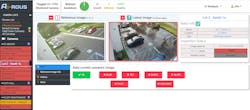Ai-RGUS bringing ‘AI efficiency’ to camera system health, management
Ai-RGUS, which makes software solutions that help organizations protect and monitor the functionality of their security cameras, plans to showcase its AI software solution at the upcoming Global Security Exchange 2023 in Dallas this month.
SecurityInfoWatch.com recently caught up with Ai-RGUS Chief Scientist and CEO Daniel Reichman to discuss how the company evolved, how its technology benefits organizations with large cameras systems, and new integrations with major cloud video management and ticketing system providers.
You can catch up with Ai-RGUS at booth 4481 at GSX 2023 in Dallas, Texas, slated for Sept. 11-13.
SIW: Tell us how your company was founded and your main focus in the security industry.
Reichman: Duke University asked our lab to develop the software for their security system that included approximately 2,000 cameras. We worked on image processing and they asked us to develop the software for them.
Being completely new to the security industry we asked ourselves, ‘Why doesn’t this technology (that AI-RGUS features) exist?’ We spoke with numerous other camera system owners to understand what their existing practices were for maintaining their camera system.
Camera systems aren’t very often part of legislation and not every vertical is necessarily required to have that. But we found all sorts of laws, compliance regulations and internal guidelines indicating camera systems should be maintained. But how that’s typically translated into a security management program is complete patchwork.
If so many people can pass a multi-million-dollar investment in security camera systems through a budget, there should be a way to ensure they get the value. Duke explained that if our cameras are getting vibrated in the parking lot and pointing at the floor, or the wrong part of the lot, what are they good for? A lot of integrators and users echoed the same sentiment.”
SIW: Explain what Duke University achieved with this technology in terms of problems identified and time saved.
Reichman: Duke used to have a person do this work (checking cameras). It would take them four to five hours each day to review them. They weren't going through all 2,000 cameras a day. Now it takes about five minutes a day. That’s a pretty significant time savings.
We have another case study with Elite Interactive Solutions, which manages over 5,000 cameras. Even though they’re a remote monitoring company that employs people to watch cameras all day to determine if a crime is happening, they still use us. They’re not reviewing all the cameras to be sure one isn’t getting blocked by a tree or anything else. If they don’t hear from a camera, they assume there’s no problem.
If you find a camera that’s not recording you might think ‘Okay, it happened five days ago. No worries, I'll pull the footage from over the weekend.’ But the hard drive could be full and that footage might not exist by the weekend. So all these little things creep up on you.
SIW: Every time something is interconnected in security systems there could be an opportunity for hackers. How do you handle the security aspects with your software so they can’t use it as a backdoor to get into someone's camera system?
Reichman: Our software is implemented on ISO 27001 servers and data centers. We conduct an annual penetration test of our software and we follow the principle of least access. That means when a new user is provisioned, they can only see what their administrator permits them to see and not more.
We also let users manage their cybersecurity stance, since we offer in our product -- for camera models that are supported -- the ability to manage passwords so you can set a template for your password management.
Let’s say you want a complicated password on your cameras. We can do a mass update of all your cameras to conform to that standard and give you notifications that, for example, it’s been six months and you should do it again. We also let users do bulk updates of their firmware and manage firmware versions of their cameras.
It’s not that simple to do very often if you need to log into each individual camera and perform your actions. If you have even 100 cameras, you’ll probably never do it because it’s so painful. Through our system it’s possible to click all the buttons, update the 100 cameras and off it goes.
You get a report letting you know what worked, what didn't work and what you should fix. So that makes it feasible for a company to be compliant in cybersecurity for their camera system.”
SIW: What are you hoping to accomplish being at GSX this year? And who are you trying to reach?
We believe that a camera system without monitoring software attached to it is not a full investment in security. Our goal is to make it a new standard in the security industry, to deploy camera systems with software that lets you know if you have something unusable from your camera system.
Our sales are made through the channel. We seek to work with system integrators who then introduce us to end users. But it's also helpful to speak with end users and educate them so that they can bring their system integrator into the loop. And that’s where GSX seems to be a good place where there’s a nice mix of both.”
We are also a recurring monthly revenue-type product where system integrators can both offer this as a self-managed service for their customers and offer it as a high-touch service for their customers.
It’s a way for them to get service calls, potentially, or to know when they should recommend a hardware replacement rather than wait for the annual review of the system. Now they can know in pretty much real time whether a hard drive needs to be replaced and actually go do it rather than wait until after there was a problem.
SIW: You’ve highlighted some new integrations recently with Eagle Eye Networks, OpenEye, Alta Aware from Avigilon, Hanwha Sync and Digital Watchdog Cloud, among others. Are those the types of companies that you're aspiring to work with in the future to expand?
Reichman: “Our goal is that independent of your choice and purchase of a camera system, you'll be able to have it monitored. These specific companies are called out because they're kind of a newer trend in the security industry of being a video search via video surveillance as a service -- meaning of DNS in the cloud.
This has pros and cons. It’s good because it’s very accessible. Let’s say when a user wants to make (the system) accessible to someone else, they’re slightly more cyber secure because it’s not port forwarding. It’s going to a secure cloud over HTTPS with someone that we the partner with, then communicate with on a secure link. It also has cons because it’s a single point of failure. Everybody works hard to make sure their cybersecurity is high and they invest a lot in it.
I should also point out that our customers of ConnectWise, Zoho, ServiceTrade and ServiceNow can export data from Ai-RGUS into their ticketing system.
The reporting of multiple camera system health metrics in the Ai-RGUS dashboard can now be automatically emailed to stakeholders, showing potential issues with a particular camera or provided as a service by a systems integrator.
About the Author
John Dobberstein
Managing Editor/SecurityInfoWatch.com
John Dobberstein is managing editor of SecurityInfoWatch.com and oversees all content creation for the website. Dobberstein continues a 34-year decorated journalism career that has included stops at a variety of newspapers and B2B magazines. He most recently served as senior editor for the Endeavor Business Media magazine Utility Products.

